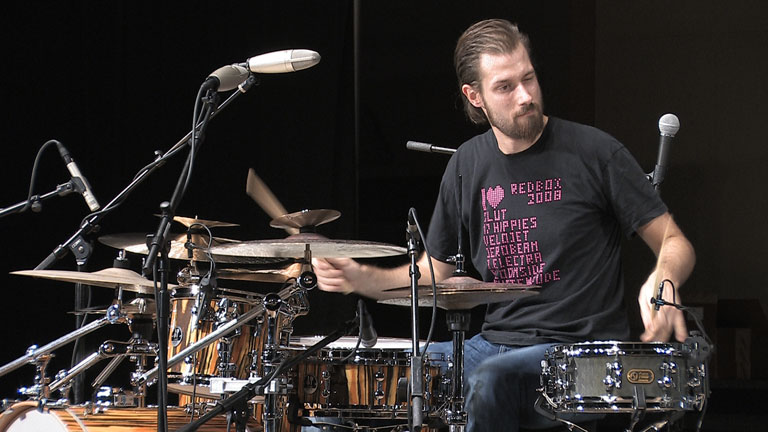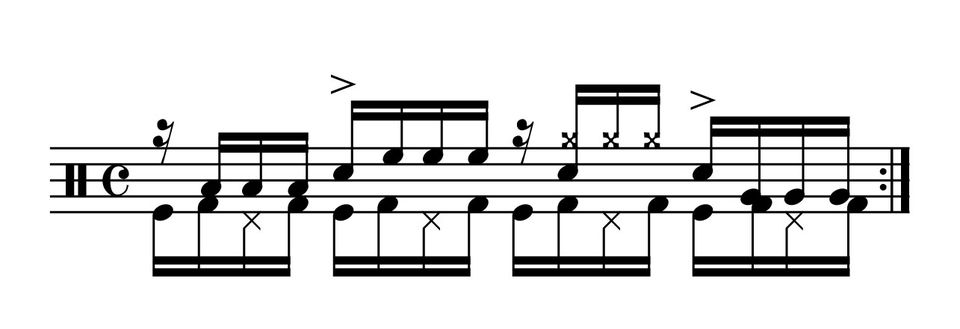PART ONE

If you are looking for a deliciously rich, coordination challenge to add to your drumming vocabulary, this drum groove/solo served up by Benny Greb during his drumset clinic at the 2009 Percussive Arts Society International Convention (PASIC) is sure to satisfy.
As you’ll see in my video clip from the clinic, Benny makes use of a number of different drumming elements in his drum solo: 4-way independence and multi-pedal technique, plus a simultaneous hand ostinato and foot ostinato. For those not familiar with the term, an ostinato is a motif or phrase that persistently repeats itself.
Here is the full notation of the basic groove that Benny begins at the 08:00 time mark, continuing for four measures then embellishing and using the groove to improvise over.

As you can see and hear, there are a lot of ingredients to this groove recipe. All of the limbs are involved, coordinated together in such a way that when we watch and listen to Benny play, or even view the notation of the groove, we might consider this to be one of those "no way" 4-way independence contraptions — one that only a select few could even attempt, let alone play. Before you check-out or lose hope, let me first explain and show how to approach learning this groove.
We could attack this complex groove note-by-note, starting at the beginning of the measure and working our way through, however, breaking this beast down into bite size pieces, limb by limb, is the best way to go about it. The reason? The goal here is more than just playing the notated groove. We will want to develop our limb coordination to the point we have complete independence between the ostinatos and the improvised solo elements. Understanding and being able to perform these ostinatos independent of one another is going to give us the greatest flexibility, not only with this particular groove, but with everything we choose to do with it.
PART TWO
Left Foot
The anchor to Benny's drum groove is the left foot ostinato — playing eighth-notes, moving back-and-forth from the bass drum (slave) pedal to the hi-hat pedal. If you did not already realize this, in order to execute this ostinato you will need a double kick pedal or two bass drums. While we could certainly substitute the bass drum sound, such as playing straight eighth-notes with the foot using only the hi-hat, the overall sound and feel of this groove is centered around the downbeats, played by the bass drum, which outlines the pulse. For building the same coordination or creating a new sound, use whatever you have at your disposal, such as losing the multi-pedal approach and just make use of your hi-hats.
Here's what the left foot is playing:

Be sure to work this slowly, making certain that you can play steady eighth-notes with the left foot, all on the hi-hat or all on the bass drum, before attempting the multi-pedal maneuver. Notice that Benny is allowing his hi-hats to immediately open as they play on the upbeats, thus creating a splash effect.
Right Foot
The right foot is playing its own ostinato; offbeat sixteenth-notes on the bass drum with the main kick pedal. The simplest way to think of this is to just play straight eighth-notes with the right foot, starting them a sixteenth-note after the downbeat.

Foot Ostinato
Once we understand what each foot is doing, we can combine the two feet and basically think of this as one ostinato between the bass drum and hi-hat, played by the feet. For those who are used to playing single alternating strokes with the feet, leading with the left foot, and making use of a double kick pedal, it makes sense to start here. However in this case, breaking the parts down, showing what each foot is doing individually, is a true benefit. Not only will it help us own what we are playing, but also ingrain the ostinato in our muscle memory to the point that we can go on autopilot.
Here is the foot ostinato — single strokes, leading with the left foot and using the multi-pedal technique. Remember to work slowly, gradually building your speed without sacrificing precision. Be sure to add a little more weight to the downbeat on the bass drum with the left foot; marking the pulse for the listener and establishing the correct permutated gallop feel.

PART THREE
Right Hand Ostinato
The right hand in Benny's drum groove is playing its own separate ostinato pattern against the foot ostinato. The fact that this three-note grouping in the right hand starts after each downbeat may feel awkward at first or seem impossible to perform — I assure you that it is easier than it looks.
First, let us play the right hand ostinato on one surface, like the snare drum.

Practice this slowly with a metronome. Counting out loud as you play, marking the downbeats (ie. 1 2 3 4), is a great way to really own this pattern. Next, try adding the left foot playing only the downbeats on 1 2 3 4 ... this means your foot is essentially playing on the rests within the right hand ostinato. Got that happening? Now add the complete left foot ostinato (eighth-notes) with the right hand ostinato (still on one surface).

Now let us add the full, complete foot ostinato that incorporates both feet and play the right hand ostinato, still just on one surface. Notice how the right hand begins with the right foot. The three-note grouping in the right hand lines up so that the first and third note lands with the right foot on the bass drum; the second note lands with the left foot on the hi-hat. You should now begin to see (and feel) how this is much simpler than it looks. The way our brain processes these coordinations, any time we have our right side (hand/foot) move in unison, the better it is.

Let us go back now to just working with the right hand and practice moving around to different voices in the kit. Benny Greb uses a three tom toms and an X-hat (sometimes ride cymbal) in the right hand ostinato. His tom configuration is one mounted tom (up) and two floor toms (down). While he varies the voicings from time to time, the basic sequence used in this ostinato is as follows: Tom 2, Tom 1, X-Hat, Tom 3. You can see this notated in the full groove transcription (see Part One). Once moving from voice to voice (drum to drum) feels comfortable, let us build this up slowly like we did before, adding the left foot downbeats only, then the full left foot ostinato, then the right foot ostinato, then the full foot ostinato using both feet. Again, work slowly and with a metronome (when possible). Listen for rhythmic eveness in each limb as well as precise strokes when voices (ie. drum or cymbal) should be in unison (not flamming).
PART FOUR
Hand Ostinato with Backbeats
Now we are ready to start putting the final touches on the groove; applying the left hand backbeats to the right hand ostinato. In the first four-bar phrase of this groove, which is what we are focusing on, Benny just plays backbeats (2 and 4) on the snare drum with the left hand. There's also a tap on the sixteenth-note after beat three. Practice by first adding the backbeats (see notation below), then catch the tap stroke. Start slowly, listening for clarity, rhythmic precision and the double-stop (two hand unison), with the tap stroke (on the snare drum) and hi-hat.

Once we have the hands working together, the right hand ostinato around the kit with the left hand backbeats, we need to combine it with the foot ostinato — and then we are done, well maybe.

BONUS
Here is what Benny is doing with the left hand in the four measures that follows the initial four measures we just worked on. The left hand continues to play the backbeats and tap stroke on the primary snare drum as before, but also incorporates additional rhythms on a secondary snare drum (notated with triangle noteheads). If you don't own a second snare drum, don't worry! You could literally use any percussion instrument you want (eg. cowbell, woodblock, tambourine, etc.) and it will sound great.

One final note — once you have put this all together — don't stop with just mastering the coordination in this groove (or anything you play); there is so much more than what is notated. Listen to how Benny phrases and shapes the various parts to convey his musical thoughts and feelings. Listen to what you are playing, even record yourself. Try to emulate Benny's phrasing, then add your own ideas. Explore, create, and make it your own.






